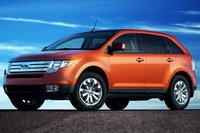Ford SUV Earns Insurance Industry's Top Safety Award
ARLINGTON, Va., June 25, 2007 -- The 2008 Ford Taurus X, a midsize SUV, meets the criteria to win the Insurance Institute for Highway Safety's TOP SAFETY PICK award. Winners of this designation afford superior overall crash protection among the vehicles in their class. To qualify for TOP SAFETY PICK, a vehicle must earn the highest rating of good in all three Institute tests -- front, side, and rear -- and be equipped with electronic stability control.
"Criteria to win are tough because the award is intended to drive continued safety improvements such as high crash test ratings and rapid addition of electronic stability control, which is standard equipment on the Taurus X," says Institute president Adrian Lund. "Recognizing vehicles at the head of the class for safety helps consumers distinguish the best overall choices without having to sort through multiple results."
Initially only 13 cars, minivans, and SUVs qualified for 2007 awards. As automakers introduce new models or make safety changes to existing ones, the Institute adds winners throughout the year. Ford's Freestyle, predecessor to the Taurus X, earned top crash test ratings but didn't qualify for the 2007 award because electronic stability control wasn't available.
"In a competitive marketplace, automakers are striving to earn safety accolades," Lund points out. "We congratulate Ford for having more models that earn TOP SAFETY PICK from the Institute than any other car company."
Seven of the 22 current TOP SAFETY PICKs are from Ford or its subsidiary, Volvo.
How vehicles are evaluated: The Institute's frontal crashworthiness evaluations are based on results of 40 mph frontal offset crash tests. Each vehicle's overall evaluation is based on measurements of intrusion into the occupant compartment, injury measures recorded on a Hybrid III dummy in the driver seat, and analysis of slow-motion film to assess how well the restraint system controlled dummy movement during the test.
Side evaluations are based on performance in a crash test in which the side of a vehicle is struck by a barrier moving at 31 mph. The barrier represents the front end of a pickup or SUV. Ratings reflect injury measures recorded on two instrumented SID-IIs dummies, assessment of head protection countermeasures, and the vehicle's structural performance during the impact. Injury measures obtained from the two dummies, one in the driver seat and the other in the back seat behind the driver, are used to determine the likelihood that a driver and/or passenger in a similar real-world crash would sustain serious injury to various parts of the body. The movements and contacts of the dummies' heads during the test also are evaluated. Structural performance is based on measurements indicating the amount of B-pillar intrusion into the occupant compartment.
Rear crash protection is rated according to a two-step procedure. Starting points for the ratings are measurements of head restraint geometry -- the height of a restraint and its horizontal distance behind the back of the head of an average-size man. Seat/head restraints with good or acceptable geometry are tested dynamically using a dummy that measures forces on the neck.



